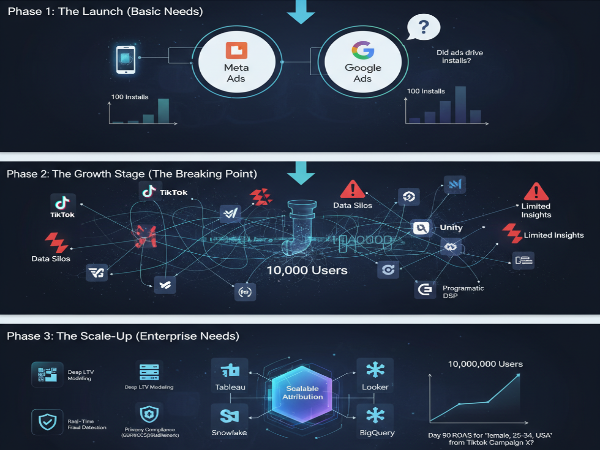Mobile Attribution That Scales With Your Business

When your app first launches, success feels simple. Your goal is to get your first 100, then 1,000, then 10,000 users. You are likely running a few ads on major platforms like Meta or Google, and your main question is “did my ads drive installs?” At this stage, a simple attribution report is all you need. But what happens when you hit an inflection point?
Suddenly, your goals are far more complex. You are not just aiming for 10,000 users; you are aiming for 10 million. Your marketing budget is 100x larger, and you are advertising across dozens of networks, not just two. The simple tools you started with are now cracking under the pressure. This is the moment every app developer and marketer faces. You do not just need attribution; you need attribution that scales.
What Does “Scalable Attribution” Mean?
“Scalable” is a term that gets thrown around a lot, but in the context of mobile attribution, it has a very specific meaning. It is the difference between a tool that simply counts installs and a data platform that can grow with your business. It is the core challenge for modern marketers, who need scalable attribution for growth teams to make intelligent, high-stakes decisions.
Scalable attribution is not just about handling more data. It is about handling more complexity, depth, and speed. It is defined by a few key pillars:
- Volume: The ability to process billions of events (clicks, installs, in-app actions) per month without delays or data loss.
- Complexity: The capacity to track and de-duplicate users across dozens of ad networks, influencer campaigns, email lists, and organic sources simultaneously.
- Depth: Moving beyond the install to track detailed in-app events, revenue, lifetime value (LTV), and return on ad spend (ROAS).
- Integration: The power to connect seamlessly with your entire tech stack, including data warehouses, BI tools, and CRM platforms.
The Journey of an App: From Launch to Global Scale
To understand why scalability is so vital, it helps to look at the typical stages of an app’s growth and how its attribution needs change.
Phase 1: The Launch (Basic Needs)
In the beginning, your team is small, and your goal is validation. Your primary attribution question is: “Which ad network drove this install?” You are using the built-in dashboards of your ad networks or perhaps a free-tier Mobile Measurement Partner (MMP). Your focus is on the top of the funnel. The problem is, this gives you a very limited view. You know you got 100 installs from Campaign A, but you have no idea if they were good users.
Phase 2: The Growth Stage (The Breaking Point)
This is where most apps feel the pain. Your user acquisition (UA) budget is growing. You are now active on 10 or 15 different channels, including TikTok, Unity, AppLovin, and programmatic DSPs. The problems become obvious:
- Data Silos: Your Google data is in Google Ads. Your Meta data is in Meta. You cannot easily compare the LTV of a user from one channel versus another.
- Fraud: As your budget grows, you become a target. Ad fraud, like click spamming and SDK spoofing, starts to eat into your budget, and your simple system cannot detect it.
- Limited Insights: You need to know more than just installs. You need to know which campaigns drive users who register, complete the tutorial, or make a purchase. Your basic setup cannot handle this level of granular event tracking.
Phase 3: The Scale-Up (Enterprise Needs)
Your app is now a serious business. Your growth team is sophisticated. They are not asking “how many installs?” They are asking “What is the Day 90 ROAS for the ‘female, 25-34, USA’ cohort that came from TikTok campaign X?”
At this stage, your team demands:
- Raw Data Access: They do not want to be limited by a dashboard. They want a “data firehose” to pipe every click, install, and event directly into their own BI tools like Tableau or Looker.
- Deep LTV Modeling: They need to build complex predictive models, and that requires granular, user-level data.
- Privacy Compliance: They are operating globally and must navigate complex privacy laws like GDPR and CCPA, plus the challenges of SKAdNetwork on iOS.
A system that is not built for this level of scale will simply fail, leaving your team blind at the exact moment they need the most insight.
Key Features That Define a Scalable Attribution Platform
When a growth team is looking for an attribution partner, they are vetting for a specific set of features that enable scale.
Granular Post-Install Event Tracking
Scalability means moving far beyond the install. A scalable platform allows you to define and track a virtually unlimited number of in-app events. You can map the entire user journey, from registration_complete and tutorial_finished to add_to_cart, first_purchase, and subscription_activated. This allows you to optimize your ad spend not for cheap installs but for high-value users.
Raw Data and BI Integrations
This is non-negotiable for a modern growth team. They do not want to be trapped in a third-party dashboard. They need the ability to get real-time, user-level raw data delivered directly to their data warehouse (like BigQuery, Snowflake, or Redshift). This allows them to build their own LTV models, create custom dashboards, and merge marketing data with their internal product analytics.
Support for a Complex Ecosystem
The mobile world is messy. A scalable solution must unify data from every corner of the ecosystem. This includes:
- SKAdNetwork: Providing clean, aggregated, and insightful reporting for iOS.
- Privacy Sandbox: Being future-proof for Google’s new framework on Android.
- Web-to-App: Seamlessly tracking users who click an ad on the mobile web and are then sent to the app.
- Deep Linking: Ensuring that a click on an ad or email link not only opens the app but takes the user to a specific page or product inside it.
Real-Time Fraud Detection
When you are spending $1,000 a month on ads, fraud is an annoyance. When you are spending $1,000,000 a month, fraud is a catastrophic expense. A scalable attribution system includes a powerful, real-time fraud filter. It should automatically detect and reject suspicious activity before it gets counted, protecting your budget and keeping your data clean.
The Cost of Not Scaling Your Attribution
Sticking with a basic attribution tool for too long is not a money-saving move. It is a massive hidden cost. The consequences are severe:
- Wasted Ad Spend: You continue to invest in channels that look good on “installs” but deliver zero long-term value.
- Data Chaos: Your marketing and product teams use different numbers, leading to conflicting reports and poor decisions.
- Inability to Adapt: When Apple launches SKAdNetwork, your system breaks, and you are flying blind for months.
- Resource Drain: Your engineers are forced to spend valuable time trying to manually pull reports and stitch data together, instead of building new product features.
Conclusion: Attribution as a Growth Lever, Not a Report
In the end, basic attribution is a rear-view mirror. It tells you what already happened. Scalable attribution is a forward-looking guide. It is an active tool that helps you navigate complex markets, find new opportunities, and deploy your budget with precision.
The right attribution system is a true partner in your growth. It provides the simple answers you need on day one and the deep, complex, granular data you need on day one thousand. It is not just a report; it is the core engine of your entire growth strategy.



